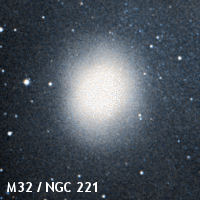
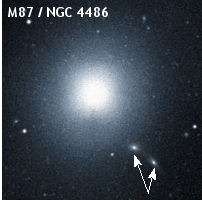 "Elliptical galaxies are ellipsoidal agglomerations of stars, which usually do not contain much interstellar matter, and look smoothly like small wads in the telescope. Sizes vary from considerably small systems (as M32 which is quite bright though) to really giant guys as M87," The other two galaxies seen in M87 (arrows) are - [DCY96] 238 & [PGH98] 1228+1238A ) Images Obtained: C.D.S. - SIMBAD4 rel 1.117 - 2009.04.15CEST21:29:43 & Aladin [2] The past twenty years have seen huge advances made in the astronomical science of galaxies. Questions, theories and hypothesized arguments have been answered or proven and issue regularly from the numerous science entities that exist online; the Astronomical Journal, SkyandTelescope magazine and institutions and universities like NASA/JPL and UCSC (University of California Santa Cruz). The last of these, in an online newsletter called Currents, published the findings of computer simulations, conducted in order to answer a challenge made in 2003 which held that the theory of dark cold matter — every galaxy is surrounded by a halo of dark matter that can only be detected indirectly by observing its gravitational effects — did not exist in elliptical galaxies. The issue is an important one as it relates directly to the science and dynamics of galaxy evolution. As Joel Primack, professor of physics and a coauthor of the Nature paper, noted: "if those galaxies don't have dark matter it calls into question the whole theory of cold dark matter" [3]
"Elliptical galaxies are ellipsoidal agglomerations of stars, which usually do not contain much interstellar matter, and look smoothly like small wads in the telescope. Sizes vary from considerably small systems (as M32 which is quite bright though) to really giant guys as M87," The other two galaxies seen in M87 (arrows) are - [DCY96] 238 & [PGH98] 1228+1238A ) Images Obtained: C.D.S. - SIMBAD4 rel 1.117 - 2009.04.15CEST21:29:43 & Aladin [2] The past twenty years have seen huge advances made in the astronomical science of galaxies. Questions, theories and hypothesized arguments have been answered or proven and issue regularly from the numerous science entities that exist online; the Astronomical Journal, SkyandTelescope magazine and institutions and universities like NASA/JPL and UCSC (University of California Santa Cruz). The last of these, in an online newsletter called Currents, published the findings of computer simulations, conducted in order to answer a challenge made in 2003 which held that the theory of dark cold matter — every galaxy is surrounded by a halo of dark matter that can only be detected indirectly by observing its gravitational effects — did not exist in elliptical galaxies. The issue is an important one as it relates directly to the science and dynamics of galaxy evolution. As Joel Primack, professor of physics and a coauthor of the Nature paper, noted: "if those galaxies don't have dark matter it calls into question the whole theory of cold dark matter" [3]It is thought that elliptical galaxies are the results of the mergering of two disk galaxies. "When two spiral galaxies merge, then the orbits of all the stars are randomized. As a result, all the stars in an elliptical galaxy have random orbits and there is not much collective motion of stars." [4]
Since dark matter halos are clearly detected in disk galaxies the question became, "where did all that dark matter go after the galaxies collided and formed an elliptical galaxy?" The answer is that it is still there but the process by which it is inferred in spiral galaxies becomes errant due to the makeup of elliptical galaxies. In the end, the study showed that "[f]rom more than 200 merger simulations run by Cox on a supercomputer at UCSC, the researchers analyzed 10 mergers that yielded elliptical galaxies with masses similar to those of the galaxies observed in 2003. The results were completely consistent with the reported observations" concluding that "what they saw is exactly what the cold dark matter model would predict..." [5]
"In the mid-seventies...it became clear that rather than being boring dynamical systems, elliptical galaxies exhibit a rich variety of shapes and internal dynamics. They are not oblate isotropic rotators, but slowly tumbling triaxial stellar systems whose internal structure is not determined by just their total mass M, and total angular momentum L" [6] In other words, these galaxies are are not simply aimless wads or flat rotating disks, but galaxies that have depth and form, their stellar components rotating on several axes [axises]. [oblate = having an equatorial diameter greater than the distance between poles; isotropic = Identical in all directions; rotator = one that rotates; triaxial = having three axes]
5. An Elliptical Galaxy Called "Peculiar"
NGC 5128 a type E0 peculiar elliptical galaxy from the Anglo-Australian Observatory
The green colored star in the dust lane is supernova 1986g.
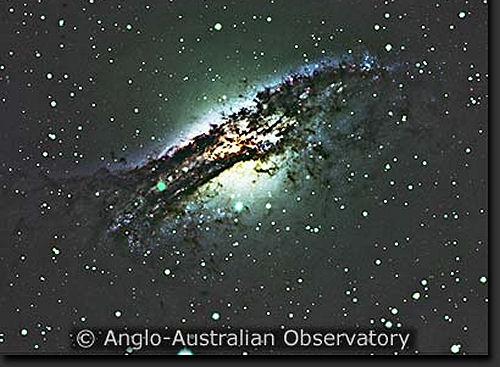 Peculiar galaxies are a branch or sub-type of the standard classification categories. They are created and/or develope as a result of the tidal interactions with other galaxies, thereby creating galaxies with unusual properties of shape, size or composition. As a class, they have been given their own catalog, the Atlas of Peculiar Galaxies which was produced by Halton Arp and originally published in 1966 by the California Institute of Technology. The atlas contains a total of 338 galaxies classified by appearence in four main catagories with a fifth used for galaxies that did not fit any of the previous catagories. "Some galaxies have additional characteristics that make them peculiar. They could show features of several galaxy types, have strong emissions of radio waves, have giant jets of gas spewing out from the nucleus, among other peculiarities." [7] In the intervening time since publication of Arp's Atlas of Peculiar Galaxies, a great deal has been learned by astronomers regarding the processes that form this class of galaxy, processes that lead to unusal shapes and designs which can create an image journey of interesting diversity.
Peculiar galaxies are a branch or sub-type of the standard classification categories. They are created and/or develope as a result of the tidal interactions with other galaxies, thereby creating galaxies with unusual properties of shape, size or composition. As a class, they have been given their own catalog, the Atlas of Peculiar Galaxies which was produced by Halton Arp and originally published in 1966 by the California Institute of Technology. The atlas contains a total of 338 galaxies classified by appearence in four main catagories with a fifth used for galaxies that did not fit any of the previous catagories. "Some galaxies have additional characteristics that make them peculiar. They could show features of several galaxy types, have strong emissions of radio waves, have giant jets of gas spewing out from the nucleus, among other peculiarities." [7] In the intervening time since publication of Arp's Atlas of Peculiar Galaxies, a great deal has been learned by astronomers regarding the processes that form this class of galaxy, processes that lead to unusal shapes and designs which can create an image journey of interesting diversity.
Below is another image of NGC 5128 with the light of the elliptical galaxy unfiltered as was done in the above image in order to bring out the details of the dust lane and star forming regions. In the center is an image of both the star Regulus and dwarf elliptical galaxy Leo I (circle) which is usually very faint and has been enhanced to bring out the galaxy's detail. On the right is a close-up image of the Leo I Dwarf Galaxy. Images at left and right from the AAO website. Center image of Regulus/Leo I by Scott Anttila, source: Wikipedia and used here under the GNU Free Documentation License & Creative Commons Attribution ShareAlike 2.5
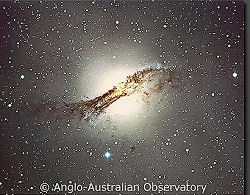
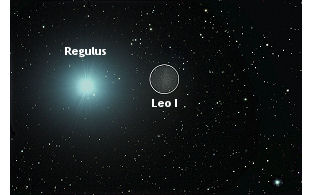
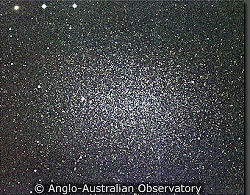
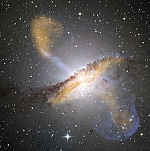
NGC 5128 - Seyfert 2 Galaxy. Location of this galaxy is RA: 13 25 27.61507 Dec: -43 01 08.8053 and was discovered by James Dunlop in 1826 and is considered as one of his most famous discovery. It's radial velocity or redshift is 548 km/s with a listed morphological type of both peculiar elliptical and sometimes lenticular. Other names for this galaxy are QSO B1322-428, ESO 270-9, LEDA 46957, CENTAURUS A or Cen A, 2MASX J13252775-4301073. The image here is a colour composite of NGC 5128, revealing the lobes and jets emanating from the active galaxy's central black hole. Credit: ESO [8]
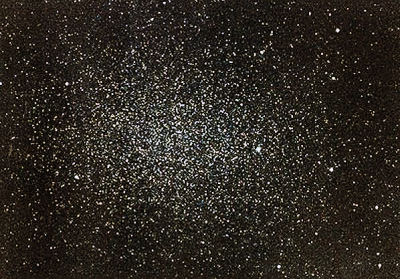
LEO I - Dwarf Elliptical Galaxy or Dwarf Spheroidal Galaxy. Location of this galaxy is RA: 10 08 28.12 Dec: +12 18 23.4 and was discovered in 1950 by R.G. Harrington and A.G. Wilson on plates of the National Geographic Society Palomar Observatory Sky Survey (POSS) obtained with the 48-inch Schmidt Telescope on Mt. Palomar (Harrington & Wilson 1950) It's radial velocity or redshift is 248 km/s with an angular size (arcmin) of 11.48 8.709 80 and a listed morphological type of dG (dwarf galaxy) Other names for this galaxy are LEO I dSph, LEDA 29488, Harrington-Wilson No1, DDO 74, Regulus Dwarf, UGC 5470 With the star Regulus outshinning the surrounding area an observer often misses Leo I — this is an enhanced view of the AAO image of Leo I as seen above right. Credit: Anglo-Australian Observatory, photograph by David Malin [9] I wish to express my particular thanks to astrophotographer David Malin for granting permission to use the images from the AAO. You can see more of David's work by clicking on his name — this will take you to his website
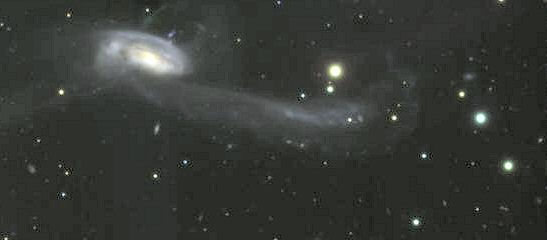
Arp 102 "This interesting interacting spiral/elliptical pair of galaxies was first described in the Catalogue of Peculiar Galaxies, compiled by Halton Arp in 1966. It is also pair number 508 in Igor Karachentsev's catalog of binary galaxies. The large spiral galaxy (type SABb pec) shows long blue tidal tails caused by its interaction with the southerly elliptical. In fact, this "elliptical" is much the more interesting galaxy, despite its more nondescript appearance. It is a broad line radio galaxy with an unresolved core and a sub-parsec VLBI component at 6cm. It is also an intermediate type Seyfert, meaning it has an active nucleus, and it shows a double-peaked emission line profile (separation about 5000 km/s), which is considered to be strong evidence for the presence of an accretion disk, probably around a central supermassive black hole." Credit: C.F.Claver, N.A.Sharp (NOAO)/WIYN/NOAO/NSF [10]
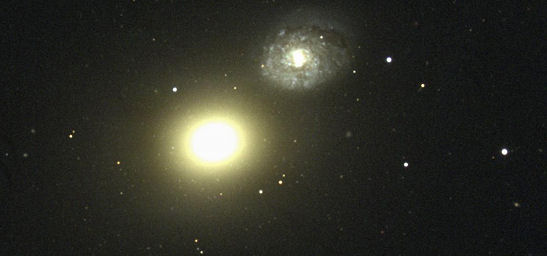
M60 - Galaxy in Pair of Galaxies. Location of this galaxy is RA: 12 43 40.19 Dec: +11 33 08.9 with a radial velocity/redshift of 1105-07 km/s, a listed morphological type of S0 and an angular size of (arcmin) 6.606 5.754 105. It was discovered by the German astronomer Johann Gottfried Koehler in April 1779 during observations of a comet in the same part of the sky. The designation M60 refers to the famous Messier Catalog — Catalogue of Nebulae and Star Clusters — created by Charles Messier, this being the 60th object therein. Both M60 and the comet that Gottfried discovered were listed in this catalog about three days after his discovery. "M60 is a large elliptical galaxy in the constellation Virgo, being about 120000 light-years across. It stands out in even small telescopes due to the proximity of the late-type spiral NGC4647 (to the NW), but such apertures may only see the central brighter regions, making M60 look considerably smaller." Credit: NOAO/AURA/NSF Other names for this galaxy include LEDA 42831, NGC 4649, 2MASX J12434000+1133093 [11]
The green colored star in the dust lane is supernova 1986g.
 Peculiar galaxies are a branch or sub-type of the standard classification categories. They are created and/or develope as a result of the tidal interactions with other galaxies, thereby creating galaxies with unusual properties of shape, size or composition. As a class, they have been given their own catalog, the Atlas of Peculiar Galaxies which was produced by Halton Arp and originally published in 1966 by the California Institute of Technology. The atlas contains a total of 338 galaxies classified by appearence in four main catagories with a fifth used for galaxies that did not fit any of the previous catagories. "Some galaxies have additional characteristics that make them peculiar. They could show features of several galaxy types, have strong emissions of radio waves, have giant jets of gas spewing out from the nucleus, among other peculiarities." [7] In the intervening time since publication of Arp's Atlas of Peculiar Galaxies, a great deal has been learned by astronomers regarding the processes that form this class of galaxy, processes that lead to unusal shapes and designs which can create an image journey of interesting diversity.
Peculiar galaxies are a branch or sub-type of the standard classification categories. They are created and/or develope as a result of the tidal interactions with other galaxies, thereby creating galaxies with unusual properties of shape, size or composition. As a class, they have been given their own catalog, the Atlas of Peculiar Galaxies which was produced by Halton Arp and originally published in 1966 by the California Institute of Technology. The atlas contains a total of 338 galaxies classified by appearence in four main catagories with a fifth used for galaxies that did not fit any of the previous catagories. "Some galaxies have additional characteristics that make them peculiar. They could show features of several galaxy types, have strong emissions of radio waves, have giant jets of gas spewing out from the nucleus, among other peculiarities." [7] In the intervening time since publication of Arp's Atlas of Peculiar Galaxies, a great deal has been learned by astronomers regarding the processes that form this class of galaxy, processes that lead to unusal shapes and designs which can create an image journey of interesting diversity.Below is another image of NGC 5128 with the light of the elliptical galaxy unfiltered as was done in the above image in order to bring out the details of the dust lane and star forming regions. In the center is an image of both the star Regulus and dwarf elliptical galaxy Leo I (circle) which is usually very faint and has been enhanced to bring out the galaxy's detail. On the right is a close-up image of the Leo I Dwarf Galaxy. Images at left and right from the AAO website. Center image of Regulus/Leo I by Scott Anttila, source: Wikipedia and used here under the GNU Free Documentation License & Creative Commons Attribution ShareAlike 2.5



6. A Gallery of Elliptical Form



